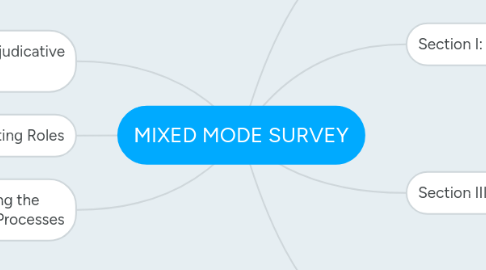
1. Section IV: Non-Adjudicative “Setting the Stage” for Adjudicative Processes
1.1. Diagnostics
1.1.1. Facilitated discussion
1.1.1.1. e.g., Guided Choice
1.1.2. Use of Forms
1.1.2.1. e.g., Olé
1.1.3. Metrics
1.1.3.1. Time
1.1.3.2. Money
1.1.3.3. Relationships
1.1.3.4. Societal/Stakeholder impacts
1.1.3.5. Other
1.1.4. Correlating to procedural options
1.1.4.1. SEQUENTIAL PROCESSES
1.1.4.1.1. Consent Awards
1.1.4.2. PARALLEL PROCESSES
1.1.4.3. INTEGRATED PROCESSES
1.2. Procedural options
1.2.1. Building blocks
1.2.1.1. Type
1.2.1.1.1. See Taxonomy
1.2.2. Possible permutations
1.2.2.1. SEQUENTIAL PROCESSES
1.2.2.2. PARALLEL PROCESSES
1.2.2.3. INTEGRATED PROCESSES
2. Section VI: Shifting Roles
2.1. Arb-Med
2.2. Med-Arb
2.3. Arb-Med-Arb
2.4. MEDALOA
3. Section V. Adjudicative"Setting the Stage" for Non-Adjudicative Processes
3.1. Diagnostics
3.1.1. Facilitated discussion
3.1.1.1. e.g., Guided Choice
3.1.2. Use of Forms
3.1.2.1. e.g., Olé
3.1.3. Metrics
3.1.3.1. Time
3.1.3.2. Money
3.1.3.3. Relationships
3.1.3.4. Societal/Stakeholder impacts
3.1.3.5. Other
3.1.4. Correlating to procedural options
3.1.4.1. SEQUENTIAL PROCESSES
3.1.4.1.1. Consent Awards
3.1.4.2. PARALLEL PROCESSES
3.1.4.3. INTEGRATED PROCESSES
3.2. Procedural options
3.2.1. Building blocks
3.2.1.1. Type
3.2.1.1.1. See Taxonomy
3.2.2. Possible permutations
3.2.2.1. SEQUENTIAL PROCESSES
3.2.2.2. PARALLEL PROCESSES
3.2.2.3. INTEGRATED PROCESSES
4. Taxonomy
4.1. Adjudicative
4.1.1. Litigation
4.1.2. Arbitration
4.1.3. MEDALOA/Baseball Arbitration?
4.1.4. Other
4.2. Non-Adjudicative
4.2.1. Evaluative
4.2.1.1. Advisory Appraisal
4.2.1.2. Advisory Expert Determination
4.2.1.3. Advisory/Non-Binding Arbitration
4.2.1.4. Conciliation
4.2.1.5. Dispute Review Board
4.2.1.6. Evaluative Mediation
4.2.1.7. Early Neutral Evaluation
4.2.1.7.1. = Conciliation?
4.2.1.8. Mini-Trial
4.2.1.9. MEDALOA?
4.2.1.10. Other
4.2.2. Non-Evaluative
4.2.2.1. Non-Evaluative Mediation
4.2.2.2. Transformative Mediation
4.2.2.3. Facilitative Mediation
4.2.2.4. Other
5. Section I: Initial Questionnaire
5.1. Consent to use data and participate
5.2. Personal ID and info
5.2.1. Education
5.2.1.1. Qualifications/Certifications
5.2.1.2. Jurisdictions of training
5.2.1.3. Jurisdictions of practice
5.2.2. Occupation
5.2.2.1. Current
5.2.2.1.1. Self-employed
5.2.2.1.2. Employee
5.2.2.1.3. Size of organisation
5.2.2.2. Past
5.2.2.2.1. Self-employed
5.2.2.2.2. Employee
5.2.2.2.3. Size of organisation
5.2.3. Experience
5.2.3.1. Usual Role
5.2.3.1.1. As Party
5.2.3.1.2. As Advisor
5.2.3.1.3. As Neutral
5.2.3.2. Preferred Role
5.2.3.2.1. As Party
5.2.3.2.2. As Advisor
5.2.3.2.3. As Neutral
5.2.3.3. Jurisdiction
5.2.3.3.1. Local
5.2.3.3.2. International
5.2.4. Procedural Preferences
5.2.4.1. As party
5.2.4.1.1. Adjudicative
5.2.4.1.2. Non-Adjudicative
5.2.4.2. As advisor
5.2.4.2.1. Adjudicative
5.2.4.2.2. Non-Adjudicative
5.2.4.3. As neutral
5.2.4.3.1. Adjudicative
5.2.4.3.2. Non-Adjudicative
5.2.5. Age
5.2.6. Years in practice
5.2.7. Gender
5.3. Level of Interest in specific topics below
5.3.1. Adjudicative Processes
5.3.1.1. Scale of 1-5
5.3.2. Non-Adjudicative Processes
5.3.2.1. Scale of 1-5
5.3.3. Non-Adjudicative for Adjudicative
5.3.3.1. Scale of 1-5
5.3.4. Adjudicative for Non-Adjudicative
5.3.4.1. Scale of 1-5
5.3.5. Shifting Roles
5.3.5.1. Scale of 1-5
6. Section III: Non-adjudicative Processes
6.1. Evaluative
6.1.1. Experience
6.1.1.1. Role
6.1.1.1.1. As Neutral
6.1.1.1.2. As Party
6.1.1.1.3. As Advisor
6.1.1.2. Type
6.1.1.2.1. Advisory Appraisal
6.1.1.2.2. Advisory Expert Determination
6.1.1.2.3. Advisory/Non-Binding Arbitration
6.1.1.2.4. Dispute Review Board
6.1.1.2.5. Early Neutral Evaluation
6.1.1.2.6. Mini-Trial
6.1.1.2.7. Other
6.1.2. Satisfaction
6.1.2.1. Advisory Appraisal
6.1.2.1.1. Scale 1-5
6.1.2.2. Advisory Expert Determination
6.1.2.2.1. Scale 1-5
6.1.2.3. Advisory/Non-Binding Arbitration
6.1.2.3.1. Scale 1-5
6.1.2.4. Dispute Review Board
6.1.2.4.1. Scale 1-5
6.1.2.5. Early Neutral Evaluation
6.1.2.5.1. = Conciliation?
6.1.2.6. Mini-Trial
6.1.2.6.1. Scale 1-5
6.1.2.7. Other
6.1.2.7.1. Scale 1-5
6.2. Non-Evaluative
6.2.1. Non-Evaluative Mediation
6.2.1.1. Experience
6.2.1.2. Satisfaction
6.2.2. Collaborative Law
6.2.2.1. Experience
6.2.2.2. Satisfaction
6.2.3. Other
6.2.3.1. Experience
6.2.3.2. Satisfaction
6.3. Mixed Non-Adjudicative Processes
6.3.1. Co-mediation
6.3.1.1. Evaluative mediator
6.3.1.2. Non-Evaluative mediator
7. Section II. Adjudicative processes
7.1. Litigation
7.1.1. Domestic
7.1.1.1. Metrics
7.1.1.1.1. Time
7.1.1.1.2. Money
7.1.1.1.3. Relationships
7.1.1.1.4. Societal/Stakeholder impacts
7.1.1.1.5. Other
7.1.1.2. Satisfaction
7.1.2. International
7.1.2.1. Metrics
7.1.2.1.1. Time
7.1.2.1.2. Money
7.1.2.1.3. Relationships
7.1.2.1.4. Societal/Stakeholder impacts
7.1.2.1.5. Other
7.1.2.2. Satisfaction
7.2. Arbitration
7.2.1. Domestic
7.2.1.1. Metrics
7.2.1.1.1. Time
7.2.1.1.2. Money
7.2.1.1.3. Relationships
7.2.1.1.4. Societal/Stakeholder impacts
7.2.1.1.5. Other
7.2.1.2. Satisfaction
7.2.2. International
7.2.2.1. Metrics
7.2.2.1.1. Time
7.2.2.1.2. Money
7.2.2.1.3. Relationships
7.2.2.1.4. Societal/Stakeholder impacts
7.2.2.1.5. Other
7.2.2.2. Satisfaction
7.3. Other
7.3.1. Metrics
7.3.1.1. Time
7.3.1.2. Money
7.3.1.3. Relationships
7.3.1.4. Societal/Stakeholder impacts
7.3.1.5. Other
7.3.2. Satisfaction
